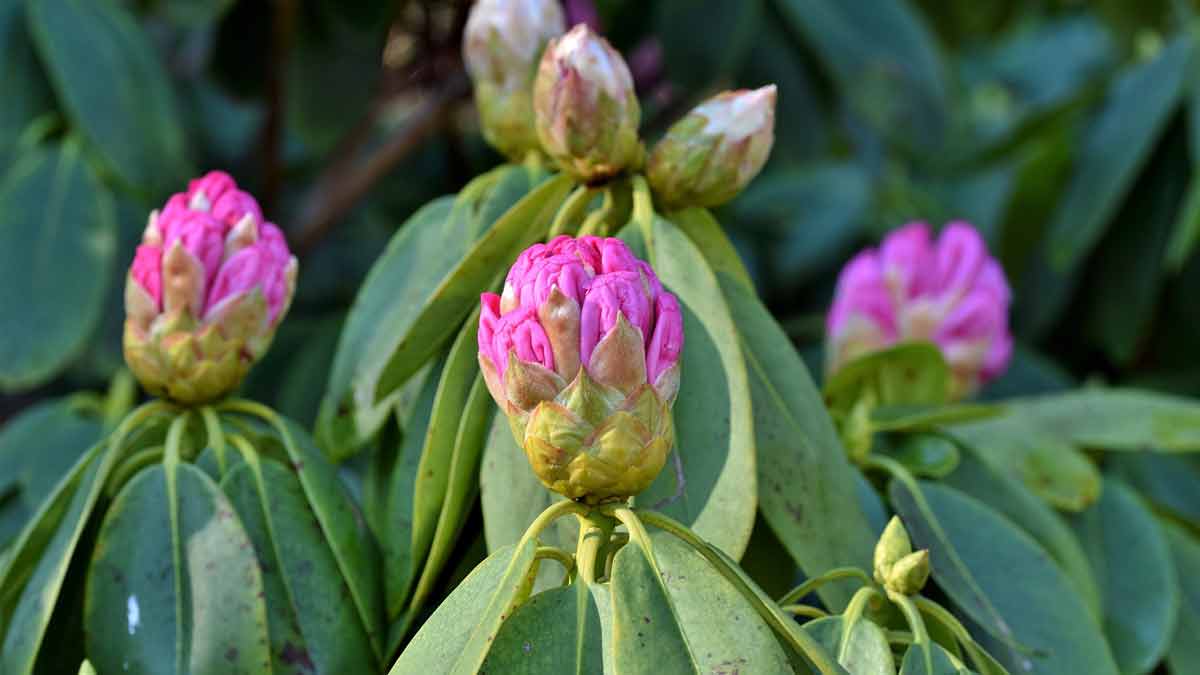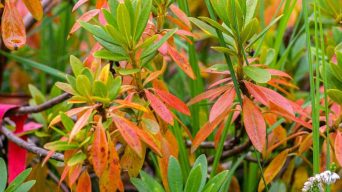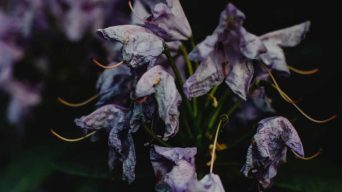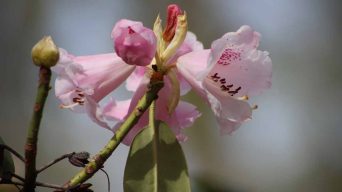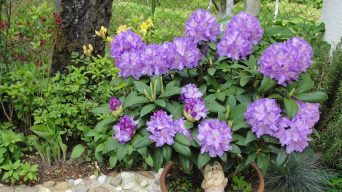Rhododendron plants are prized for their large, showy flowers and glossy green leaves.
These plants can be grown as shrubs or small trees and are popular choices for landscaping.
However, rhododendrons can sometimes develop black spots on their leaves.
There are a few different reasons why black spots might form on rhododendron leaves, but most of them are relatively easy to solve.
What Causes Black Spots on Rhododendron Leaves and How Can You Fix It?
Several different things can cause black spots on rhododendron leaves.
The most common causes are overwatering, fungal diseases, or pests. These problems are usually easy to fix with the proper care.
If your rhododendron has black spots on its leaves, it’s essential to figure out the cause so you can treat it properly.
Here are five of the most common causes of black spots on rhododendron leaves and what you can do to fix them.
1. Overwatering
Overwatering is one of the most common reasons for black spots on rhododendron leaves.
It is a common problem when gardeners give their plants too much water.
This can happen for various reasons, such as watering too often, using a pot that doesn’t have proper drainage, or not allowing the soil to dry out between waterings.
When a plant is overwatered, the roots cannot get the oxygen they need to function correctly.
This can cause several problems for plants, including stunted growth, yellow leaves, and root rot.
It can also cause black spots on leaves because it creates the perfect environment for fungal diseases to take hold.
You can tell if your rhododendron is overwatered if the leaves are wilted or yellow, the stems are soft, or there is water standing in the pot.
How To Treat Overwatering
If you think your rhododendron is overwatered, the first thing you should do is stop watering it until the soil has a chance to dry out.
You might need to water it less often or use a pot with better drainage.
If the problem is severe, you might need to repot your plant in fresh, dry soil.
Rhodendron plants are sensitive to overwatering, so it is essential not to water them too often.
Only water your rhododendron when the soil is dry to the touch.
If you’re unsure whether your plant needs water, it’s better to err on the side of caution and wait a few days before watering it again.
2. Fungal Diseases
Fungal diseases are another common cause of black spots on rhododendron leaves.
These diseases are caused by fungi in the soil and plant surfaces.
They can be spread by water, wind, or even insects.
Fungal diseases often occur in wet or humid conditions, which is why they are more common in spring and summer.
The most common fungal diseases that affect rhododendrons are black spot, sooty mold, leaf spot, and anthracnose.
Black Spot Fungus
Black spot fungus is a common fungal disease that affects rhododendrons.
This disease is caused by a type of fungus called Diplocarpon rosae.
Black spot fungus appears as black spots on the leaves of affected plants.
The spots are usually circular and have a yellow halo around them.
The black spots are fungal spores that are spread by wind and water.
Once the spores land on a leaf, they germinate and begin to feed on the tissue.
As the fungus grows, it produces more spores, infecting other leaves.
Black spot fungus can cause the leaves of affected plants to turn yellow and drop off.
This disease is most common in areas with high humidity, such as the southeastern United States.
How To Treat Black Spot Fungus
If you think your rhododendron has black spot fungus, the first thing you should do is remove any affected leaves.
This will help to prevent the fungus from spreading.
You should also make sure to dispose of the leaves properly, so they don’t infect other plants.
It’s also a good idea to rake up any fallen leaves and dispose of them.
This will help to prevent the fungus from overwintering in your garden.
You can also treat black spot fungus with a natural fungicide, such as neem oil or sulfur.
These are effective at controlling the fungus and preventing it from spreading.
However, they need to be applied regularly to be effective.
Sooty Mold
Sooty mold is another common fungal disease that affects rhododendrons.
This disease is caused by a type of fungus called Capnodium spp.
Sooty mold appears as a black, sooty substance on the leaves of affected plants.
The fungus feeds on the honeydew produced by aphids and other sucking insects.
As the fungus grows, it produces more spores, infecting other leaves.
Sooty mold can cause the leaves of affected plants to turn yellow and drop off.
The plant may also produce fewer flowers.
How To Treat Sooty Mold
To control sooty mold, you must control the population of aphids and other sucking insects.
You can do this by using a natural insecticide, such as insecticidal soap or neem oil.
This will kill the insects and prevent them from producing honeydew, which the sooty mold fungus needs to survive.
You can also remove affected leaves and dispose of them properly.
This will help to prevent the spread of the disease.
The sooty mold will disappear when the pests are under control, and the honeydew is gone.
Fungal Leaf Spot
A fungal disease called leaf spot is one of the most common reasons for black spots on rhododendron leaves.
A variety of different fungi causes this disease.
The leaf spot symptoms include small, circular, brown, or black spots on the leaves.
A yellow halo may surround the spots. In severe cases, the spots can coalesce to form large patches of dead tissue on the leaves.
Leaf spot is most common in wet or humid conditions.
The best way to prevent leaf spot is to plant rhododendrons in well-drained soil and avoid overhead watering.
How To Treat Leaf Spot
If you already have leaf spot, the best way to treat it is to remove and destroy any affected leaves.
You should also ensure to rake up any fallen leaves and dispose of them.
This will help to prevent the spread of the disease.
You can also treat leaf spot with a natural fungicide, such as neem oil or sulfur.
These are effective at controlling the fungus and preventing it from spreading.
However, they need to be applied regularly to be effective.
Anthracnose
Anthracnose is a common disease affecting many plants, including rhododendrons.
The disease is caused by a fungus called Colletotrichum lagenarium and is characterized by black spots on the leaves.
The spots are small at first, but they can eventually coalesce and cause the leaves to turn brown and wither.
The fungus can also affect the stems of the plant, causing cankers.
Anthracnose is most commonly seen in wet weather conditions or when the plant is grown in an overly humid environment.
The fungus thrives in these conditions and can quickly spread to other parts of the plant.
How To Treat Anthracnose
The best way to control anthracnose is to prevent it in the first place.
Make sure to plant your rhododendron in an area that has good drainage and isn’t overly humid.
Water the plant at the base rather than from above, and avoid getting water on the leaves.
If the leaves do get wet, make sure to dry them off as soon as possible.
If your plant is already affected by anthracnose, you can remove and dispose of the affected leaves.
This will help to prevent the fungus from spreading.
You can also treat the plant with a natural fungicide, such as neem oil.
This will help kill the fungus and prevent it from causing further damage.
3. Bacterial Infection
Bacterial infections are another common cause of black spots on rhododendron leaves.
The most common bacterial disease that affects rhododendrons is called bacterial leaf spot.
Bacterial Leaf Spot
The bacterial leaf spot disease is caused by the bacterium Xanthomonas campestris pv. vitians.
This bacterium enters the plant through wounds in the leaves or stems. Once inside, it multiplies and causes black spots on the leaves.
The spots are usually circular and have a raised water-soaked appearance.
The edges of the spots may be yellow or brown.
Bacterial leaf spot is most common in late spring and early summer.
It can weaken the plant and reduce its vigor.
How To Treat Bacterial Leaf Spot
To treat bacterial leaf spot, start by pruning away any affected leaves.
Destroy the leaves by burning them or placing them in a plastic bag and the trash.
Do not compost them.
Next, water your rhododendron with a bactericide that contains copper.
This will help to kill the bacteria and prevent it from spreading.
Finally, keep the area around your rhododendron clean and free of debris.
This will help to prevent the bacteria from infecting your plant again in the future.
4. Viral Infection
Viral infections are another possible cause of black spots on rhododendron leaves.
Many different viruses can infect rhododendrons.
These viruses are spread by insects that feed on the plant’s leaves.
They can also be spread through contaminated pruning tools or by planting infected plants.
Symptoms of a viral infection include black spots on the leaves, stunted growth, and deformed leaves.
The plant may also produce fewer flowers than usual.
How To Treat Viral Infections
Unfortunately, there is no cure for a viral infection.
Once infected, a plant will remain infected for the rest of its life.
The best way to deal with a viral infection is to prevent it in the first place.
Ensure you acquire robust rhododendron specimens from a well-established nursery prioritizing plant health.
Insects can spread viruses, so control them in your garden.
If you find an infected plant, remove it from your garden and destroy it.
Do not compost it.
5. Pests
Pests can also be responsible for black spots on rhododendron leaves.
Aphids, scale insects, and mites are common pests that can attack rhododendrons.
Aphids
Aphids are small, pear-shaped insects that suck the sap from plants.
They are usually green or black but can also be yellow, brown, or red.
They congregate in large numbers on the undersides of leaves and can cause the leaves to turn yellow or brown.
Aphids can also cause houseplant leaves to curl and distort, producing a sticky substance called honeydew that can attract other pests and promote the growth of sooty mold.
Scale insects
Scale insects are small, wingless creatures that attach themselves to plants and suck the sap out of them.
They are usually brown or black, producing a hard shell that protects them from predators and allows them to survive winter.
Scale insects can infest both the leaves and stems of rhododendrons.
They can cause the leaves to turn yellow or brown and the stems to become stunted.
They also produce honeydew, which can attract other pests and promote the growth of sooty mold.
Mites
Mites are tiny spider-like creatures that feed on the sap of plants.
They are usually red but can also be brown or black.
Mites can cause leaves to turn yellow or brown, and they can also cause the leaves to curl and distort.
Mites are particularly damaging to young rhododendron plants.
How To Control Pests
If you suspect that pests are responsible for the black spots on your rhododendron leaves, you can do a few things to control them.
First, you can try to remove the pests by hand. With a soft cloth or a cotton swab, gently wipe the undersides of the leaves where the pests congregate.
You can also use a hose to spray the leaves and dislodge the pests.
If you have a severe infestation, you can use a natural insecticide such as neem oil or insecticidal soap.
You can also try to control pests by making your rhododendron less attractive to them.
This can be done by removing dead leaves or flower heads and pruning away any infested branches.
You can also try to attract beneficial insects such as ladybugs and lacewings, which feed on common rhododendron pests.
How To Prevent Black Spots on Rhododendron Leaves
Black spots on rhododendron leaves are a common problem for gardeners.
The good news is that you can do a few things to prevent them from happening in the first place.
Here are some tips:
- Water early in the day so the leaves have time to dry before nightfall. This will help to prevent the development of fungal diseases.
- Avoid overhead watering, which can promote fungal growth. Water at the base of the plant instead.
- Only water when the soil is dry. Overwatering can lead to fungal diseases.
- Use a well-drained soil mix. Rhododendrons prefer slightly acidic soil that is rich in organic matter.
- Make sure the pot has drainage holes. Rhododendrons will not tolerate sitting in water.
- Ensure that the plant has good air circulation. Proper spacing and pruning will help to prevent fungal diseases from developing.
- Inspect the plant regularly for signs of pests or diseases. Treat the problem immediately if you see anything suspicious.
Following these tips can help prevent black spots from forming on your rhododendron leaves.
Final Thoughts
Rhododendron plants are generally very easy to take care of.
However, like with any plant, they can sometimes experience problems.
One such problem is black spots on the leaves.
There are a few different things that could be causing black spots on your Rhododendron leaves, but the good news is that they are all relatively easy to fix.
If you think your plant is suffering from any of the issues discussed in this article, then make sure to take the appropriate steps to rectify the situation.
By doing so, you should see a dramatic improvement in the health of your Rhododendron plant in no time!

